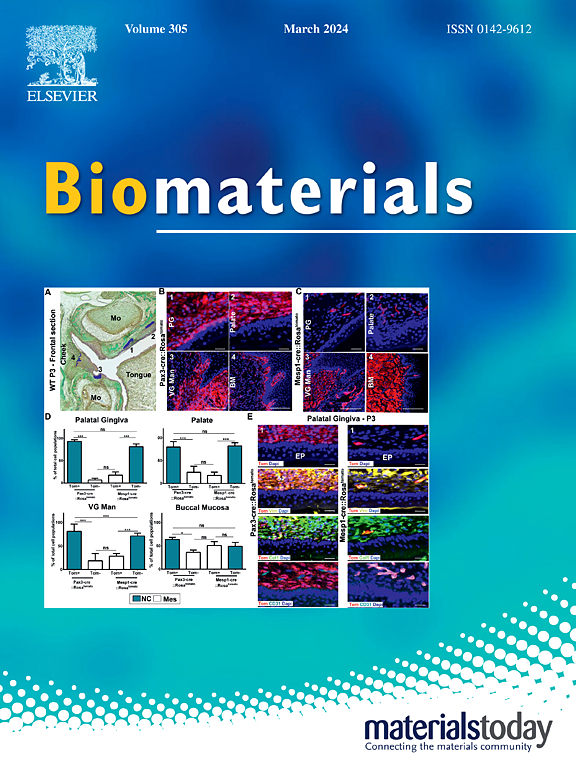Soft tissue integration around dental implants: A pressing priority
IF 12.8
1区 医学
Q1 ENGINEERING, BIOMEDICAL
引用次数: 0
Abstract
While osseointegration has traditionally been the focal point of dental implant design, recent research highlights the equally crucial role of establishing a resilient and biologically integrated soft tissue seal for long-term implant success. This review critically examines recent advances (primarily from the past five years) that elucidate the molecular, cellular, and materials science strategies essential for enhancing peri-implant soft tissue integration. Key factors include precisely engineered surface topographies at micro- and nanoscale levels, surface chemical modifications that enhance wettability and protein adsorption, and biomimetic coatings incorporating extracellular matrix-derived peptides, chemokines, and growth factors. Recent studies underscore the impact of laser micro- and nano-texturing, plasma treatments, and biofunctionalization in modulating fibroblast and epithelial cell behaviors, accelerating tissue attachment, and mitigating early inflammatory responses. Emerging implant-abutment designs, such as platform switching and transmucosal zirconia abutments, demonstrate improved soft tissue stability and reduce crestal bone loss. Additionally, the immunomodulatory potential of next-generation materials offers promising avenues for directing macrophage polarization and enhancing wound resolution. Collectively, this review synthesizes the latest evidence on material-driven and biological strategies for engineering a stable soft tissue interface. It provides a translational roadmap for the development of implant systems optimized for long-term soft tissue health, addressing a critical unmet need in dental implantology.
植牙周围的软组织整合:当务之急
虽然骨整合传统上一直是牙科种植体设计的焦点,但最近的研究强调了建立弹性和生物整合的软组织密封对于长期种植成功同样重要的作用。这篇综述批判性地审查了最近的进展(主要来自过去的五年),这些进展阐明了增强种植体周围软组织整合所必需的分子、细胞和材料科学策略。关键因素包括精确设计的微纳米级表面形貌,增强润湿性和蛋白质吸附的表面化学修饰,以及包含细胞外基质衍生肽、趋化因子和生长因子的仿生涂层。最近的研究强调了激光微纳米纹理、等离子体治疗和生物功能化在调节成纤维细胞和上皮细胞行为、加速组织附着和减轻早期炎症反应方面的影响。新兴的种植基台设计,如平台切换和经粘膜氧化锆基台,显示出更好的软组织稳定性和减少牙冠骨质流失。此外,下一代材料的免疫调节潜力为指导巨噬细胞极化和增强伤口愈合提供了有希望的途径。总的来说,这篇综述综合了材料驱动和生物策略的最新证据,用于工程稳定的软组织界面。它为长期软组织健康优化种植系统的发展提供了一个转化路线图,解决了牙科种植学中一个关键的未满足的需求。
本文章由计算机程序翻译,如有差异,请以英文原文为准。
求助全文
约1分钟内获得全文
求助全文
来源期刊

Biomaterials
工程技术-材料科学:生物材料
CiteScore
26.00
自引率
2.90%
发文量
565
审稿时长
46 days
期刊介绍:
Biomaterials is an international journal covering the science and clinical application of biomaterials. A biomaterial is now defined as a substance that has been engineered to take a form which, alone or as part of a complex system, is used to direct, by control of interactions with components of living systems, the course of any therapeutic or diagnostic procedure. It is the aim of the journal to provide a peer-reviewed forum for the publication of original papers and authoritative review and opinion papers dealing with the most important issues facing the use of biomaterials in clinical practice. The scope of the journal covers the wide range of physical, biological and chemical sciences that underpin the design of biomaterials and the clinical disciplines in which they are used. These sciences include polymer synthesis and characterization, drug and gene vector design, the biology of the host response, immunology and toxicology and self assembly at the nanoscale. Clinical applications include the therapies of medical technology and regenerative medicine in all clinical disciplines, and diagnostic systems that reply on innovative contrast and sensing agents. The journal is relevant to areas such as cancer diagnosis and therapy, implantable devices, drug delivery systems, gene vectors, bionanotechnology and tissue engineering.
 求助内容:
求助内容: 应助结果提醒方式:
应助结果提醒方式:


